New Delhi (India), May 29: As a creative strategist, diving into branding means unraveling the unique stories woven into the fabric of different cultures. In India and the USA, two distinct narratives emerge, each reflecting how brands connect with people’s lives.
In India, accessibility takes center stage, resonating with the chorus of inclusivity amidst a billion voices. Here, brands navigate the diverse economic strata and cultural patchwork, prioritizing the democratization of dreams. A stroll through an aisle takes us from the humble one-rupee shampoo packet to the opulent 3000-rupee bottle, each product on the shelf representing a narrative of affordability and accessibility. It’s not just about transactions; it’s about empowerment, resilience, and celebrating the innate spirit of innovation ingrained within Indian culture.
On the flip side, American branding is all about aspiration. Here, brands don’t just sell products; they sell dreams. From sleek smartphones to designer handbags, every purchase is a statement—a symbol of status, success, and the pursuit of the elusive American Dream. And lately, there’s been a surge in the popularity of what we call “badge brands”—the ones with logos so iconic; they’re practically works of art. These brands don’t just offer products; they offer a lifestyle, an identity, a sense of belonging.
But what’s really fascinating is how these two approaches intersect and influence each other. In India, the focus on accessibility doesn’t mean sacrificing aspiration—it’s about making the dream achievable for everyone. And in the USA, even the most aspirational brands understand the role of accessibility. This balance helps position the country as a trailblazer in innovation, creativity, and setting lifestyle trends on a global scale.
Ultimately, the branding dichotomy between accessibility in India and aspirationality in the USA is more than just a marketing strategy—it’s a reflection of the values, aspirations, and cultural nuances that define each nation. By understanding and embracing these differences, brands can create meaningful connections with consumers, driving innovation, fostering economic growth, and shaping the world we live in through more ordinary nuances.
In celebrating these differences, brands forge authentic connections with consumers, igniting the flames of innovation, fostering economic prosperity, and sculpting the tapestry of our shared existence. Examples such as Tata Group in India and Apple in the USA serve as guiding lights.
In an era where borders blur, brands traverse, and content flows freely, this dichotomy between accessibility and aspirationality becomes increasingly crucial. Brands serve as more than just products or services—they are vehicles of culture, carrying the collective experiences, memories, and ideas of people from around the world. Understanding and leveraging the interplay between accessibility and aspirationality in branding is not just about marketing strategies; it’s about finding our shared identity.
About the Author
Ria Shah is a brand strategist and designer based in Brooklyn, New York, with a keen focus on exploring the intricate differences between brands and how to harmoniously bring them together. Originally from India, Ria brings a unique perspective shaped by diverse cultural experiences. With a passion for translating facts, thoughts, and experiences into captivating narratives, Ria is adept at crafting compelling stories that resonate with audiences. Her work spans various industries and disciplines, from social impact initiatives to Fortune 500 companies.
Ria’s expertise lies in leveraging data and insights to create engaging brand stories that foster meaningful connections and drive positive change. With a client portfolio including Archie Comics, Google, Leslie Lohman Museum of Art, MasterCard, Industree Foundation, and more, she continues to make a mark in the world of branding and design, one compelling story at a time.
If you have any objection to this press release content, kindly contact [email protected] to notify us. We will respond and rectify the situation in the next 24 hours.




